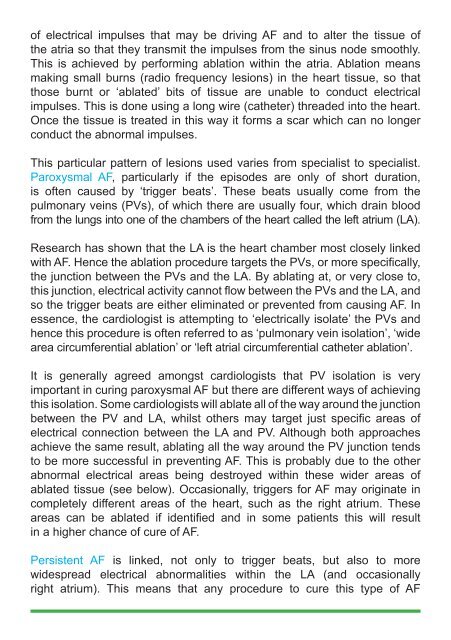CATHETER ABLATION FOR ATRIAL FIBRILLATION
Download and print - Atrial Fibrillation Association (AFA)
Download and print - Atrial Fibrillation Association (AFA)
- No tags were found...
You also want an ePaper? Increase the reach of your titles
YUMPU automatically turns print PDFs into web optimized ePapers that Google loves.
of electrical impulses that may be driving AF and to alter the tissue of<br />
the atria so that they transmit the impulses from the sinus node smoothly.<br />
This is achieved by performing ablation within the atria. Ablation means<br />
making small burns (radio frequency lesions) in the heart tissue, so that<br />
those burnt or ‘ablated’ bits of tissue are unable to conduct electrical<br />
impulses. This is done using a long wire (catheter) threaded into the heart.<br />
Once the tissue is treated in this way it forms a scar which can no longer<br />
conduct the abnormal impulses.<br />
This particular pattern of lesions used varies from specialist to specialist.<br />
Paroxysmal AF, particularly if the episodes are only of short duration,<br />
is often caused by ‘trigger beats’. These beats usually come from the<br />
pulmonary veins (PVs), of which there are usually four, which drain blood<br />
from the lungs into one of the chambers of the heart called the left atrium (LA).<br />
Research has shown that the LA is the heart chamber most closely linked<br />
with AF. Hence the ablation procedure targets the PVs, or more specifi cally,<br />
the junction between the PVs and the LA. By ablating at, or very close to,<br />
this junction, electrical activity cannot fl ow between the PVs and the LA, and<br />
so the trigger beats are either eliminated or prevented from causing AF. In<br />
essence, the cardiologist is attempting to ‘electrically isolate’ the PVs and<br />
hence this procedure is often referred to as ‘pulmonary vein isolation’, ‘wide<br />
area circumferential ablation’ or ‘left atrial circumferential catheter ablation’.<br />
It is generally agreed amongst cardiologists that PV isolation is very<br />
important in curing paroxysmal AF but there are different ways of achieving<br />
this isolation. Some cardiologists will ablate all of the way around the junction<br />
between the PV and LA, whilst others may target just specifi c areas of<br />
electrical connection between the LA and PV. Although both approaches<br />
achieve the same result, ablating all the way around the PV junction tends<br />
to be more successful in preventing AF. This is probably due to the other<br />
abnormal electrical areas being destroyed within these wider areas of<br />
ablated tissue (see below). Occasionally, triggers for AF may originate in<br />
completely different areas of the heart, such as the right atrium. These<br />
areas can be ablated if identifi ed and in some patients this will result<br />
in a higher chance of cure of AF.<br />
Persistent AF is linked, not only to trigger beats, but also to more<br />
widespread electrical abnormalities within the LA (and occasionally<br />
right atrium). This means that any procedure to cure this type of AF


